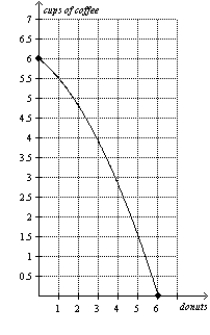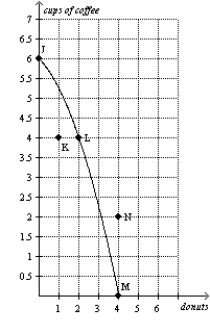A) positive statements, they are speaking not as scientists but as policy advisers.
B) positive statements, they are speaking not as scientists but as forecasters.
C) normative statements, they are speaking not as scientists but as policy advisers.
D) normative statements, they are speaking not as policy advisers but as model-builders.
F) B) and C)
Correct Answer

verified
Correct Answer
verified
Multiple Choice
In the simple circular-flow diagram, households
A) are the only decision makers.
B) own the factors of production.
C) are buyers of inputs.
D) consume only some of the goods and services that firms produce.
F) All of the above
Correct Answer

verified
Correct Answer
verified
Multiple Choice
Figure 2-9
Panel (a) Panel (b) 
 -Refer to Figure 2-9, Panel (a) and Panel (b) . A shift of the economy's production possibilities frontier from Panel (a) to Panel (b) could be caused by
-Refer to Figure 2-9, Panel (a) and Panel (b) . A shift of the economy's production possibilities frontier from Panel (a) to Panel (b) could be caused by
A) unemployment.
B) an improvement in donut production technology.
C) an improvement in coffee production technology.
D) an improvement in both donut and coffee production technology.
F) B) and D)
Correct Answer

verified
Correct Answer
verified
Multiple Choice
A relatively flat demand curve indicates that
A) quantity demanded will adjust only slightly to a price change.
B) quantity demanded will adjust significantly to a price change.
C) quantity demanded will not adjust to a price change.
D) the change in quantity demanded will exactly equal a change in price.
F) A) and B)
Correct Answer

verified
Correct Answer
verified
Multiple Choice
Yi and Avik are both economists. Yi thinks that taxing consumption, rather than income, would result in higher household saving because income that is saved would not be taxed. Avik does not think that household saving would respond much to a change in the tax laws. In this example, Yi and Avik
A) hold different normative views about the tax system.
B) disagree about the validity of a positive theory.
C) have a fundamental misunderstanding of the tax system.
D) More than one of the above is correct.
F) None of the above
Correct Answer

verified
Correct Answer
verified
Short Answer
Just like other scientific models, economic models simplify reality using
Correct Answer

verified
Correct Answer
verified
Multiple Choice
Normative conclusions
A) come from positive analysis alone.
B) are based on ignorance of positive analysis.
C) involve value judgments.
D) reflect the economist's role as scientist.
F) B) and D)
Correct Answer

verified
Correct Answer
verified
True/False
In the circular-flow diagram, factors of production are the goods and services produced by firms.
B) False
Correct Answer

verified
Correct Answer
verified
True/False
The circular flow model is not used anymore because it fails to perfectly replicate real world situations.
B) False
Correct Answer

verified
Correct Answer
verified
Multiple Choice
Alfonso has noticed that increases in unemployment insurance claims are associated with recessions, and therefore he advocates limits on unemployment insurance so as to prevent recessions. Mary has noticed that most drug addicts once attended schools, and therefore she advocates getting rid of schools so as to prevent drug addiction.
A) The reasoning of both Alfonso and Mary suffers from the omitted variable problem.
B) The reasoning of both Alfonso and Mary suffers from the reverse causality problem.
C) Alfonso's reasoning suffers from the reverse causality problem, and Mary's reasoning suffers from the omitted variable problem.
D) Mary's reasoning suffers from the reverse causality problem, and Alfonso's reasoning suffers from the omitted variable problem.
F) A) and D)
Correct Answer

verified
Correct Answer
verified
Multiple Choice
A survey which sought the opinion of professional economists on fourteen propositions about economic policy found that
A) the respondents were almost equally divided on the propositions.
B) the respondents favored the propositions by a slight margin.
C) the respondents disagreed with the propositions by a slight margin.
D) there was overwhelming endorsement of the propositions among the respondents.
F) A) and C)
Correct Answer

verified
Correct Answer
verified
True/False
Different values are not a reason for disagreement among economists.
B) False
Correct Answer

verified
Correct Answer
verified
True/False
In the circular-flow diagram, firms own the factors of production and use them to produce goods and services.
B) False
Correct Answer

verified
Correct Answer
verified
True/False
The Congressional Budget Office, which is staffed by economists, provides Congress with independent evaluations of policy proposals.
B) False
Correct Answer

verified
Correct Answer
verified
Multiple Choice
The point where both x and y are zero is known as the
A) origin.
B) null.
C) zero coordinate.
D) center.
F) C) and D)
Correct Answer

verified
Correct Answer
verified
Multiple Choice
Which of the following is a positive, as opposed to a normative, statement?
A) The US Department of Justice should allow a merger between AT&T and T-Mobile because it would have little effect on consumers.
B) Antitrust laws should be used to prevent further concentration in the wireless telephone service market.
C) The US Department of Justice sued AT&T to block its merger with T-Mobile.
D) The wireless telephone service market is too highly concentrated.
F) B) and C)
Correct Answer

verified
Correct Answer
verified
Multiple Choice
According to economist John Maynard Keynes, a great economist must also be a(n)
A) mathematician.
B) historian.
C) philosopher.
D) All of the above are correct.
F) C) and D)
Correct Answer

verified
Correct Answer
verified
Multiple Choice
Which of the following is not an example of a graph of a single variable?
A) a pie chart
B) a bar graph
C) a time-series graph
D) a scatterplot
F) A) and B)
Correct Answer

verified
Correct Answer
verified
Multiple Choice
Figure 2-9
Panel (a) Panel (b) 
 -Refer to Figure 2-9, Panel (a) . Production is
-Refer to Figure 2-9, Panel (a) . Production is
A) possible at points J, K, L, and M, but efficient only at points J, L, and M.
B) possible at points J, K, L, and M, but efficient only at point K.
C) possible at points J, L, M, and N, but efficient only at points J, L, and M.
D) possible at points J, L, M, and N, but efficient only at point N.
F) A) and B)
Correct Answer

verified
Correct Answer
verified
Multiple Choice
Figure 2-9
Panel (a) Panel (b) 
 -Refer to Figure 2-9, Panel (a) . The opportunity cost of one cup of coffee is highest when the economy produces
-Refer to Figure 2-9, Panel (a) . The opportunity cost of one cup of coffee is highest when the economy produces
A) 0 cups of coffee.
B) 2 cups of coffee.
C) 4 cups of coffee.
D) 6 cups of coffee.
F) A) and B)
Correct Answer

verified
Correct Answer
verified
Showing 321 - 340 of 617
Related Exams